Abstract
To compare the refractory period that follows exercise and isocapnic hyperventilation, 10 asthmatic children performed two pairs of challenge tests in random order at least six hours apart. In pair A a hyperventilation challenge was followed by an exercise challenge and in pair B the order was reversed. Both pairs of tests were done while the children were breathing cold dry air. Tests were matched in terms of work load, ventilation, and end tidal carbon dioxide tension (PCO2). The mean percentage fall in FEV1 (delta FEV1) after the first challenge (hyperventilation) of pair A and the first challenge (exercise) of pair B were the same (30% (SEM 2%)) and 30% (4%) respectively). The mean delta FEV1 of the exercise test following hyperventilation in pair A and of hyperventilation following exercise in pair B was 22% (4%) and 18% (4%) respectively. Both these latter results were significantly lower than the respective delta FEV1 when the challenge was the first test of the pair. Although the mean refractoriness index (reduction in induced asthma in the second test of each pair compared with the first test) was greater when exercise was the first challenge, the difference was not significant.
Full text
PDF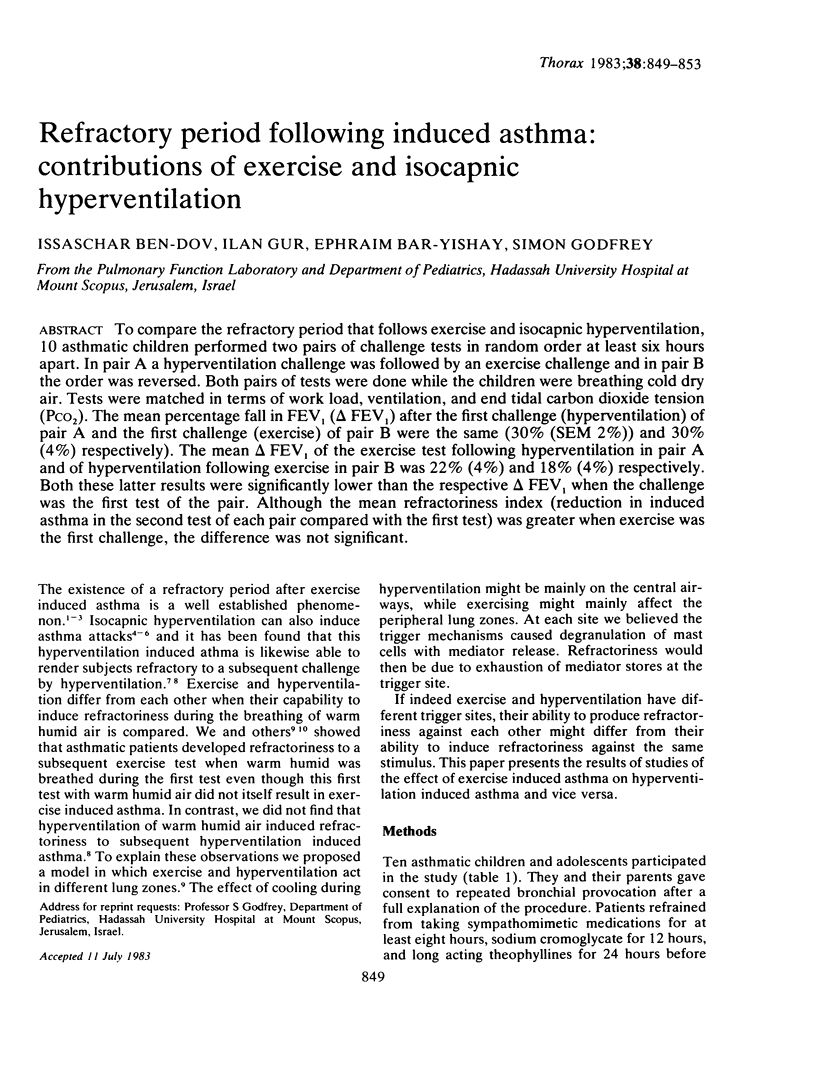
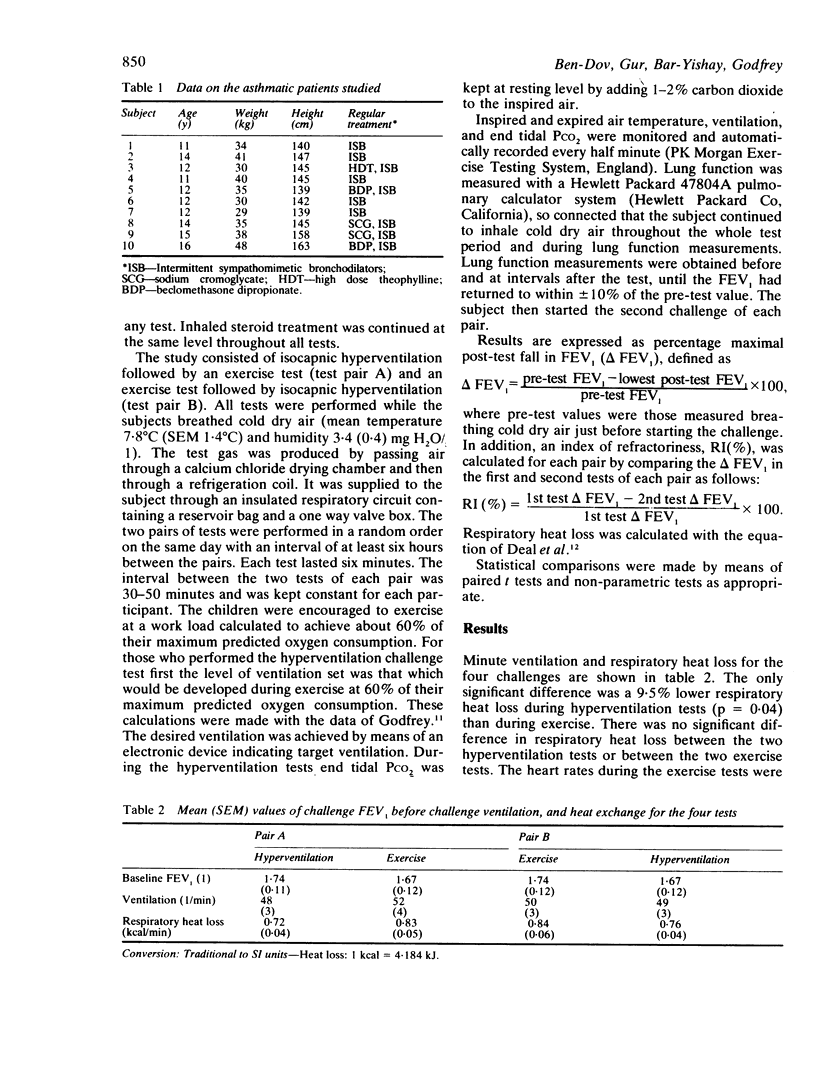
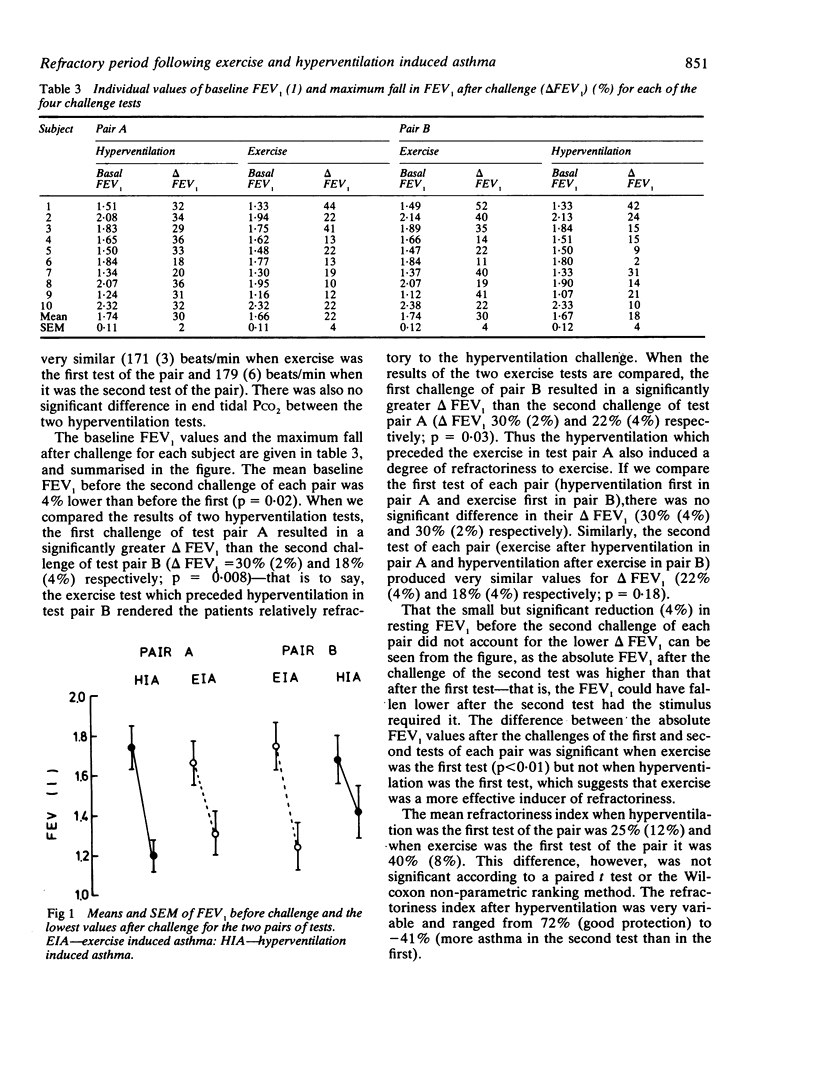
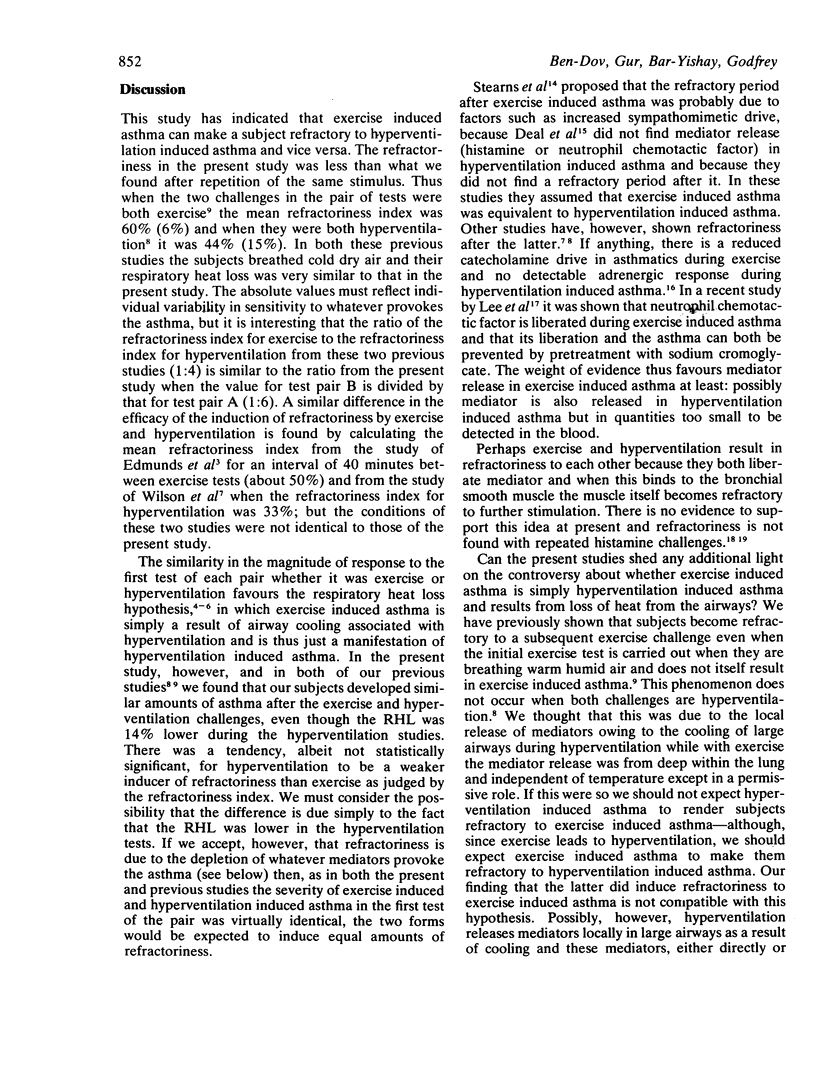
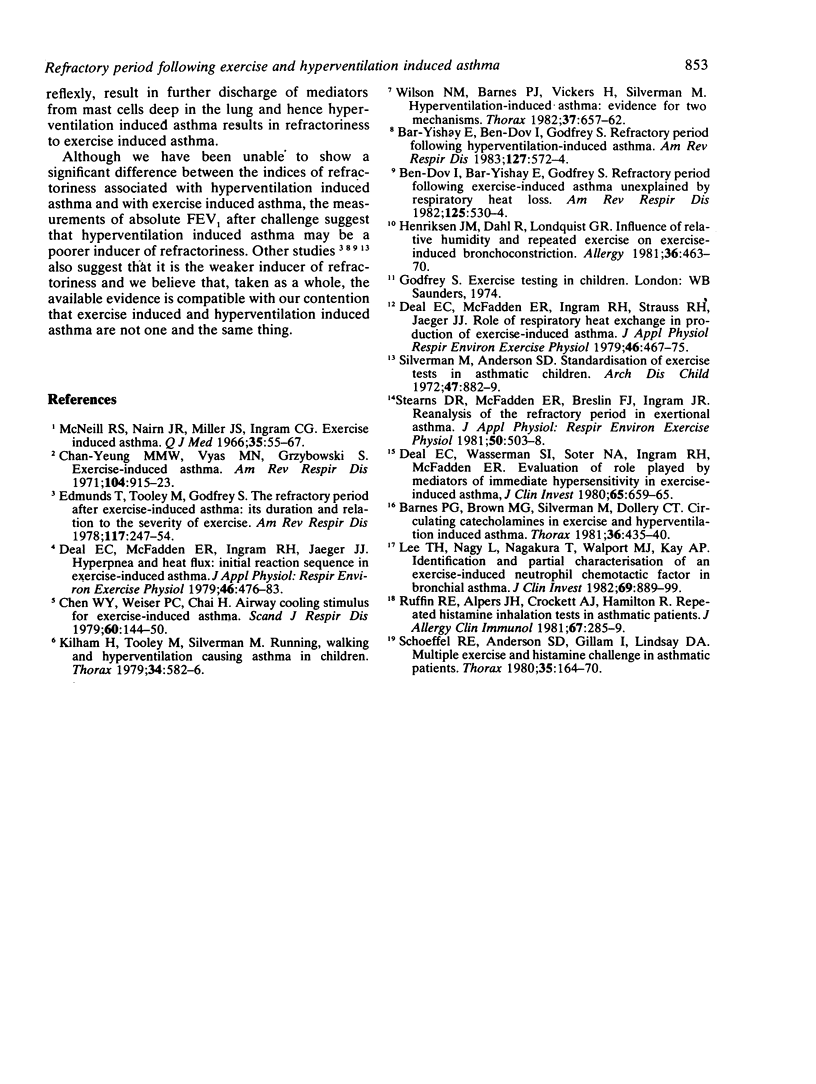
Selected References
These references are in PubMed. This may not be the complete list of references from this article.
- Bar-Yishay E., Ben-Dov I., Godfrey S. Refractory period after hyperventilation-induced asthma. Am Rev Respir Dis. 1983 May;127(5):572–574. doi: 10.1164/arrd.1983.127.5.572. [DOI] [PubMed] [Google Scholar]
- Barnes P. J., Brown M. J., Silverman M., Dollery C. T. Circulating catecholamines in exercise and hyperventilation induced asthma. Thorax. 1981 Jun;36(6):435–440. doi: 10.1136/thx.36.6.435. [DOI] [PMC free article] [PubMed] [Google Scholar]
- Ben-Dov I., Bar-Yishay E., Godfrey S. Refractory period after exercise-induced asthma unexplained by respiratory heat loss. Am Rev Respir Dis. 1982 May;125(5):530–534. doi: 10.1164/arrd.1982.125.5.530. [DOI] [PubMed] [Google Scholar]
- Chan-Yeung M. M., Vyas M. N., Grzybowski S. Exercise-induced asthma. Am Rev Respir Dis. 1971 Dec;104(6):915–923. doi: 10.1164/arrd.1971.104.6.915. [DOI] [PubMed] [Google Scholar]
- Chen W. Y., Weiser P. C., Chai H. Airway cooling. Stimulus for exercise-induced asthma. Scand J Respir Dis. 1979 Jun;60(3):144–150. [PubMed] [Google Scholar]
- Deal E. C., Jr, McFadden E. R., Jr, Ingram R. H., Jr, Jaeger J. J. Hyperpnea and heat flux: initial reaction sequence in exercise-induced asthma. J Appl Physiol Respir Environ Exerc Physiol. 1979 Mar;46(3):476–483. doi: 10.1152/jappl.1979.46.3.476. [DOI] [PubMed] [Google Scholar]
- Deal E. C., Jr, McFadden E. R., Jr, Ingram R. H., Jr, Strauss R. H., Jaeger J. J. Role of respiratory heat exchange in production of exercise-induced asthma. J Appl Physiol Respir Environ Exerc Physiol. 1979 Mar;46(3):467–475. doi: 10.1152/jappl.1979.46.3.467. [DOI] [PubMed] [Google Scholar]
- Deal E. C., Jr, Wasserman S. I., Soter N. A., Ingram R. H., Jr, McFadden E. R., Jr Evaluation of role played by mediators of immediate hypersensitivity in exercise-induced asthma. J Clin Invest. 1980 Mar;65(3):659–665. doi: 10.1172/JCI109711. [DOI] [PMC free article] [PubMed] [Google Scholar]
- Edmunds A. T., Tooley M., Godfrey S. The refractory period after exercise-induced asthma: its duration and relation to the severity of exercise. Am Rev Respir Dis. 1978 Feb;117(2):247–254. doi: 10.1164/arrd.1978.117.2.247. [DOI] [PubMed] [Google Scholar]
- Henriksen J. M., Dahl R., Lundqvist G. R. Influence of relative humidity and repeated exercise on exercise-induced bronchoconstriction. Allergy. 1981 Oct;36(7):463–470. doi: 10.1111/j.1398-9995.1981.tb01857.x. [DOI] [PubMed] [Google Scholar]
- Kilham H., Tooley M., Silverman M. Running, walking, and hyperventilation causing asthma in children. Thorax. 1979 Oct;34(5):582–586. doi: 10.1136/thx.34.5.582. [DOI] [PMC free article] [PubMed] [Google Scholar]
- Lee T. H., Nagy L., Nagakura T., Walport M. J., Kay A. B. Identification and partial characterization of an exercise-induced neutrophil chemotactic factor in bronchial asthma. J Clin Invest. 1982 Apr;69(4):889–899. doi: 10.1172/JCI110528. [DOI] [PMC free article] [PubMed] [Google Scholar]
- McNeill R. S., Nairn J. R., Millar J. S., Ingram C. G. Exercise-induced asthma. Q J Med. 1966 Jan;35(137):55–67. [PubMed] [Google Scholar]
- Ruffin R. E., Alpers J. H., Crockett A. J., Hamilton R. Repeated histamine inhalation tests in asthmatic patients. J Allergy Clin Immunol. 1981 Apr;67(4):285–289. doi: 10.1016/0091-6749(81)90023-3. [DOI] [PubMed] [Google Scholar]
- Schoeffel R. E., Anderson S. D., Gillam I., Lindsay D. A. Multiple exercise and histamine challenge in asthmatic patients. Thorax. 1980 Mar;35(3):164–170. doi: 10.1136/thx.35.3.164. [DOI] [PMC free article] [PubMed] [Google Scholar]
- Silverman M., Anderson S. D. Standardization of exercise tests in asthmatic children. Arch Dis Child. 1972 Dec;47(256):882–889. doi: 10.1136/adc.47.256.882. [DOI] [PMC free article] [PubMed] [Google Scholar]
- Stearns D. R., McFadden E. R., Jr, Breslin F. J., Ingram R. H., Jr Reanalysis of the refractory period in exertional asthma. J Appl Physiol Respir Environ Exerc Physiol. 1981 Mar;50(3):503–508. doi: 10.1152/jappl.1981.50.3.503. [DOI] [PubMed] [Google Scholar]
- Wilson N. M., Barnes P. J., Vickers H., Silverman M. Hyperventilation-induced asthma: evidence for two mechanisms. Thorax. 1982 Sep;37(9):657–662. doi: 10.1136/thx.37.9.657. [DOI] [PMC free article] [PubMed] [Google Scholar]


